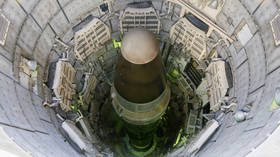California homeless deaths multiply as Covid-19 lockdowns cut off access to medical care, food & sanitation
Deaths of homeless people have spiked amid the Covid-19 pandemic – but not because of the virus. Lockdowns have deprived them of everything from medical care, to begging income, to soap and water, while shelter remains elusive.
San Francisco saw 48 deaths among its homeless population over the last two months, more than triple the fatalities seen during the same period last year, according to the city’s Department of Public Health Street Medicine Team, which shared the grim statistics with the San Francisco Chronicle on Tuesday. An average of six homeless people have died every week since the city's lockdown began in late March.
Also on rt.com I’ve seen too many families kicked out of their homes. It’s why I despair about the tsunami of evictions that’s comingWhile one might expect the coronavirus to be running rampant through shelters and encampments, the city blames the lockdown itself, which disrupted the shelters and medical services homeless people rely upon. Shelters turned inhabitants out onto the street in the name of social distancing – spooked by a “massive” Covid-19 outbreak in the city’s largest shelter – while walk-in clinics closed their doors or significantly reduced operating hours.
Those evicted from the shelters had to go somewhere, and the number of tents and other temporary structures in the city’s notorious Tenderloin neighborhood soared by 285 percent since January, compared to a 71 percent increase in the city as a whole. But makeshift outdoor residences lack running water and basic sanitation, and the unsightly, sidewalk-crowding sprawl became a haven for disease, as well as drugs and crime.
Unable to obtain medical treatment, and deprived of so much as a place to wash their hands, many of the city’s most vulnerable inhabitants saw their health decline during the coronavirus lockdown. While at least two of the dead had tested positive for coronavirus at one point, neither died of the virus, according to city health officials. Others fell victim to drug overdoses: with little to no income available through panhandling, recycling, or other typical revenue streams, the more entrepreneurially-inclined among the homeless population turned to preying on the addicts in their midst, brazenly selling narcotics (including the deadly fentanyl) out in the open.
The filth and crime eventually triggered a lawsuit from Tenderloin residents and business owners, leading Mayor London Breed to announce plans to shift the sprawling outdoor encampments into a designated area that will feature lines painted on sidewalks six feet apart so tent owners can at least maintain social distancing. More importantly, the reorganization plan adds portable public restrooms and water fountains, the absence of which has been sorely felt among homeless communities as lockdowns shutter the clinics and businesses they might once have used.
San Francisco is by no means the only city thus afflicted – Los Angeles, too, seemed initially uncertain of how to handle its massive homeless population amid the crisis, dragging its feet in installing six hand-washing stations near the city’s notorious Skid Row (population 8,500). The Los Angeles Community Action Network, a local nonprofit, bridged the gap with 30 stations of its own, fashioned from commercial trash cans and electrical junction boxes in the style of similar hygiene stations used during disease outbreaks in African nations. While the city finally contributed a few portable restrooms to the itinerant strip, even those units risk becoming infection vectors if not cleaned often enough.
Orange County has also seen a jump in the number of homeless deaths in the last two months, though officials are unsure what’s causing the increase. April was the deadliest month for the county’s homeless in five years, with 34 deaths – 80 percent more than a typical month – according to the county coroner’s office. In addition to problems accessing sanitation and medical care, many food services and outreach organizations closed their doors in mid-March and only reopened at the end of last month, leaving those unlucky enough to be without shelter out of luck as far as nutrition was concerned.
“People that weren’t connected to shelter were starving,” homeless outreach coordinator Paul Leon told local outlet Voice of OC. Meanwhile, shelters became predictable hotbeds for the virus.
With few political voices willing to advocate on their behalf, the homeless are typically forgotten during policy-making decisions. One Seattle epidemiologist published an article in March suggesting public bathrooms be shuttered to avoid spreading the virus, only to realize he’d effectively consigned tens of thousands of homeless Americans to al fresco defecation. Even cities with large unhoused populations are frequently unable to support them.
Also on rt.com Deadlier than Covid? Medics sound alarm as lockdown suicides SOAR in US – and health officials knew it would happenHowever, the homeless are far from the only ones falling victim to the US healthcare system’s dysfunction during the pandemic. The New York Times casually acknowledged on Monday that tens of thousands of people had likely died from “delaying medical treatment for other illnesses” during the pandemic, glibly sweeping these casualties in with the Covid-19 body count. A letter signed last week by 600 doctors warned President Donald Trump that the pandemic-induced shutdown was itself a “mass casualty event,” with deaths from untreated non-coronavirus conditions and suicides likely to outnumber deaths from the virus.
Think your friends would be interested? Share this story!












